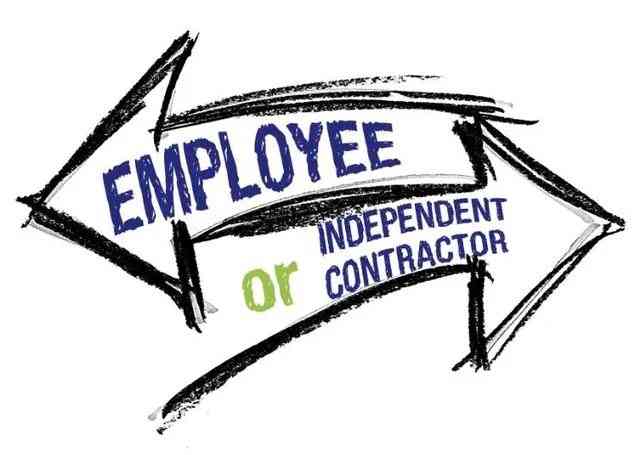
An employee and independent contractor (self-employed) may do comparable work for your company; however, there are distinct differences between the two. Whether you employ one or both classifications, you need to clearly understand the legal distinctions between them.
An employee works exclusively for a single company and will be compensated on a salaried or hourly basis. Employees are subordinate to employer authority to a greater extent than independent contractors. This means that employees will have to adhere to company policies and requirements as a contractual obligation of their employment.
When you hire an individual whom you classify an employee, your company must withhold their income tax, Social Security, and Medicare from the wages you pay them. Plus, as an employee, they’re protected under employment and labor laws.
Employees are bound by the value statement of their employer and they receive supervision, work hours, and requirements from their employer. If the work that’s accomplished and how it’s directed to be done is identified, and certain other relevant aspects of a worker’s job are directed and controlled, then the company exercises financial control.
Such control encompasses:
- The extent of the worker’s investment in the facilities or tools used in performing services.
- The extent to which the worker makes his or her services available to the relevant market.
- How the business pays the worker.
- The extent to which the worker can realize a profit or incur loss.
If the services provided are a key activity of the business, this dictates the extent to which services performed by the worker are seen as a key aspect of the regular business of the company.
Distinguishing Between Employee and Contractor
How you, the employer, and the worker perceive the relationship is also important for determining worker status. Key topics, according to the IRS, include:
- Written contracts describing the relationship the parties intend to create.
- Whether the business provides the worker with employee-type benefits, such as insurance, a pension plan, vacation, or sick pay.
- The permanency of the relationship.
- The extent to which services performed by the worker are a key aspect of the regular business of the company,
- The extent to which the worker has unreimbursed business expenses.
Contrast this to a business owner or contractor who provides services to your and other businesses. In this case, they’re generally considered self-employed/independent contractors and must handle all of the above on their own and more.
Think of your company’s relationship with an independent contractor as business-to-business. Independent contractors bring specialized expertise to a project or task. As their client, you’re not responsible for providing them with training and they can be a great way to fill your business needs.
Most independent contractors are highly skilled. They generally demonstrate a distinct level of specialization in their industry, claiming they get work assignments because they offer far reaching skills that often require certification, special training, or education.
Independent contractors work with multiple clients on a per-project basis OR with one company for a specified period of time. They are paid an hourly wage or per project and are responsible for securing (on their own) almost every benefit allocated to full-time employees.
They’re responsible for performing the services summarized in a contract, known as a Scope of Work (SOW), which outlines and executes a project through specific tasks, activities, deliverables, and timelines.
While independent contractors have freedoms, such as not being confined to working an eight-hour day, prior to COVID-19, nearly one in 10 Americans was classified as an independent contractor. They are responsible for the work and hours they keep. However, there are tradeoffs. The work might not be as steady, independent contractors provide their services to more than one company, they can subcontract with others, and they need to be sufficiently disciplined to keep scrupulous records of their earnings, because no taxes are withheld and employment and labor laws don’t apply.
While there are pros and cons to employees vs. independent contractors, below is a checklist to help you, the employer, decide which status works best for your company:
- Does your company control or have the right to control what the worker does and how the job is performed? This means complete control over work method, work product, and training.
According to the IRS, under common-law rules, anyone who performs services for you is your employee, provided you can control what will be done and how it will be done. This is so even when you give the employee freedom of action. What matters is that you have the right to control the details of how the services are performed. - Are the business aspects of the worker’s job controlled by the payer, such as does your company control the business aspects of the worker’s job, including how the worker is paid, whether expenses are reimbursed, and who provides their tools and supplies?
- Businesses must weigh all these factors when determining whether a worker is an employee or independent contractor. Some factors may indicate that the worker is an employee, while other factors indicate that the worker is an independent contractor. There is no “magic” or set number of factors that “makes” the worker an employee or an independent contractor. Also, factors that are relevant in one situation may not be relevant in another.
- Look at the entire relationship, consider the degree or extent of the right to direct and control, and finally, document each of the factors used to come up with the determination.
- Is there a written contract in place or employee benefits, such as a pension plan, insurance, or vacation pay? Although a contract may state that the worker is an employee or an independent contractor, this isn’t sufficient to determine the worker’s status. The IRS is not required to follow a contract stating that the worker is an independent contractor responsible for paying his or her own self-employment tax. How the parties work together determines whether the worker is an employee or an independent contractor.
- Is the relationship ongoing and is the work a key aspect of the business? If you hire a worker with the expectation that the relationship will continue indefinitely, rather than for a specific project or time period, this is generally considered evidence that the intent was to create an employer-employee relationship. The permanency of the relationship plays a key role.
- Are the services provided a key element of the company? This determines the extent to which the individual is viewed as an employee or independent contractor contributing to the regular business of the company.
The Internal Revenue Service uses a right-to-control test to assess a business’ tax liability. If you’ve determined that the person you’re paying is an independent contractor, then you must have the contractor complete a Form W-9, Request for Taxpayer Identification Number and Certification. This form can be used to request the correct name and Taxpayer Identification Number (TIN) of the worker. The W-9 should be kept in your files for four years for future reference in case of any inquiries from the worker or the IRS.
Each state also has tests to determine a person’s status under workers’ compensation and unemployment insurance laws. The economic realities test used in most states makes it difficult to classify a worker as an independent contractor, because, in addition to the degree of control test, it considers the degree the worker is economically dependent upon the business. For a list of state labor offices’ contact information, go to the U.S. Department of Labor’s state workforce agenciesvisit disclaimer page.
To further help employers distinguish between employees and independent contractors, the chart below depicts differences:
| Employment Laws | Covered by specific federal and state employment and labor laws | Not applicable/covered by employment and labor laws |
| Hiring Practice | Potential employee completes an application that’s handled by Human Resources. Once applicant receives and accepts a job offer, employer asks for additional information about the employee, such as date of birth, marital status, and citizenship status. | Potential contractor normally interacts with an individual or department that seeks certain services or tasks completed. Potential contractors might be asked to submit a proposal. Contractor enters into a contract, which includes a Statement of Work, with the legal or procurement section of the business. |
| Tax Documents | Employee must provide employer with name, address, Social Security number, tax filing status, and number of exemptions on a W-4 | Contractor provides name, address, Taxpayer Identification Number, and certification about back up withholdingvisit disclaimer page on a W-9 |
| Payer’s Tax Reporting Requirements | Employer reports all money paid to employee during the tax year on a W-2 | Must report payments of $600 or more in a calendar year on a Form 1099 |
| Reporting to Other Agencies | Employer files reports for state and federal unemployment insurance. | None |
| Value of Work or Contract | New employee is paid either hourly or a salary. | A contract covers payment for the for total amount. Can cover an hourly, daily, or weekly amount that ends on a specific date or a total amount to be paid in full when the job is completed. |
| When Paid | Employee must be paid consistently based on a pay schedule, as identified by employer, unless schedule is formally changed. Pay periods can vary from one week to one month; however, federal and state laws require an employee be paid on the normal pay date or earlier if the paycheck is not negotiable on the normal pay date, which can occur on holidays. | Upon receipt of an invoice/statement of services, Accounts Payable pays the contractor. The terms of the contract or Statement of Work dictate when payments are made, such as upon completion of a task or in periodic amounts. Most businesses do not pay contractors via payroll staff. |
The IRS mandates knowing the rules related to when to classify an individual as an employee vs. an independent contractor. It can help employers determine the status of their workers by using form Form SS-8, Determination of Worker Status for Purposes of Federal Employment Taxes and Income Tax Withholding. IRS Publication 15-A, Employer’s Supplemental Tax Guide, also serves as an excellent resource.
Mistaking an Employee for an Independent Contractor
If an employee is classified an independent contractor with no sound basis for doing so, the employer is liable for employment taxes. Some employers who can provide a reasonable basis for not treating a worker as an employee may avoid paying employment taxes. For more information, go to irs.gov/Publication 1976, Section 530, Employment Tax Relief Requirements.
Another option is to check the Voluntary Classification Settlement Program (VCSP) at irs.gov; it offers certain eligible businesses the option to reclassify their workers as employees with partial relief from federal employment taxes.




